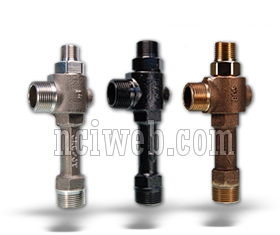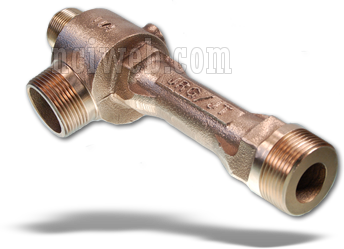How to Size Liquid Motive Eductors for Pumping Liquids
Using Liquid Motives to Pump Liquid Suction Fluids
Information required in order to properly size the eductor:
| Motive Liquid | Suction Liquid | Outlet Liquid |
|
|
|
 To determine the correct eductor for a specific application, follow the steps in this section, using the tables provided to achieve your desired results. (NOTE: All JRG/JT tables use the 1-1/2 inch unit as the standard, and eductors are sized using a Sizing Factor (S.E.) based on this standard unit.)
To determine the correct eductor for a specific application, follow the steps in this section, using the tables provided to achieve your desired results. (NOTE: All JRG/JT tables use the 1-1/2 inch unit as the standard, and eductors are sized using a Sizing Factor (S.E.) based on this standard unit.)
Step 1 Find the suction lift* or head (Hs) that is equal to or greater than your desired lift. If your lift is between two of the lifts on the table, use an average of the two. You can also or use the calculated result from the NPSH formula found on page 5 of this manual. Using the NPSH number will correct for temperature variations and friction losses, resulting in a more accurate value. (* Suction lift = vertical distance, Ft, from the suction connection to the surface of the suction liquid source. Minus = below the suction connection)
Step 2 Find the outlet head** (Ho) equal to or greater than your actual outlet head. It Is important to include friction losses into the desired outlet head. (Be certain that friction losses in the outlet line are calculated using the combined rate of both the motive and the suction flows.) It is important that the outlet line from the eductor be as large or larger than the outlet connection. (** Outlet Head = vertical distance, F, from the outlet connection to the surface or the outlet liquid destination. Positive = above the outlet connection)
 Step 3 Find the motive pressure (Pm) Locate the motive pressure from the table that is closest to or lower than your actual motive pressure. The flow specified represents the Tabulated Suction Flow for each of the different models of eductors. To determine the size of eductor needed, first use the following formula to determine the Desired Sizing Factor (S.E) Do this for each of the models.
Step 3 Find the motive pressure (Pm) Locate the motive pressure from the table that is closest to or lower than your actual motive pressure. The flow specified represents the Tabulated Suction Flow for each of the different models of eductors. To determine the size of eductor needed, first use the following formula to determine the Desired Sizing Factor (S.E) Do this for each of the models.
Desired S.F. = Desired Suction Flow ÷ Tabulated Suction Flow
If a standard unit is being used, pick the size unit that has a Tabulated S.F. equal to or greater than the Desired S.F.
If an exact match is desired, consult with us.
Step 4 Calculate the amount of motive flow used by multiplying the Qm and Qs found in the tables by the Tabulated S.F. obtained in Step 3. Do this for each of the models of eductors.
Step 5 Select the unit from Steps 1-4 that best meets the motive and suction parameters of the specific application. If a turndown ratio*** of greater than 35% is needed, then choose two or more eductors that have the correct turndown ratio and operate these units in parallel. (*** Turndown Ratio = max suction flow minus suction flow divided by max suction flow desired)
In some cases, the unit chosen will have the greatest suction flow while consuming as little motive fluid as possible. This is generally true for pumping applications. In other applications, such as the dilution of chemicals, the motive flow should be as high as possible: while the suction flow will be low. In this case, the motive flow should be matched to the desired motive flow and the suction port should be throttled to achieve the desired dilution rate. As a general rule in dilution applications, the HL is the best unit to choose.
In all cases, the correct unit is the one that matches your desired range of motive-to-suction flows the closest.
 Correcting for Non-Water Fluid Specifications (click to open/close)
Correcting for Non-Water Fluid Specifications (click to open/close)The performance specifications for JRG/JT eductors are based on using water with a specific gravity of 1.0 and a viscosity of 1 Centipoise. Fluids with differing viscosities or specific gravities need to be corrected to water, to obtain accurate performance estimates.
Viscosity is the measure of the internal resistance of a fluid to flow. This should be taken into consideration in most pressure drop and flow calculations within a given system. When used with JRG/JT eductors, fluids with viscosities of less than 100 Cp. have a negligible effect. Viscosities of up to 500 Cp. can be used with only small corrections. For higher viscosities (applications above 500 Cp.), we suggest that you work with your trained representative or the applications personnel at the factory. Eductors can be used with viscosities over 500 Cp. with calculated adjustments. The effects of viscosity on the pressure drops in the line leading to the eductor must be calculated separately.
Specific gravity is the measure of the weight per volume of a liquid. The performance data for eductors is based on water having a specific gravity of 1.0; other specific gravities will require that adjustments be made to the performance table value of the eductors. See the topics that follow for specifics on how to make these adjustments.
Motive Flow Adjustments
The motive flow is the amount of liquid used to power the eductor. To adjust the value from the performance table for specific gravity (Sg) of the motive fluid: Multiply the motive flow in the performance chart by the square root of (1/Sg).
Example : 50 GPM Tabulated Flow adjusted for a Specific Gravity of 1.3: 50 ![]() (1/1.3) = 43.85 GPM Actual motive flow
(1/1.3) = 43.85 GPM Actual motive flow
Suction Flow Adjustments
The best way to adjust for the specific gravity or temperature effects of the suction fluid is to do the calculation for NPSH (see page 5 of this manual). If you desire a rough estimate of the specific gravity effect, multiply the suction lift by the specific gravity of the liquid. If the liquid temperature exceeds 100°F, you must use the NPSH calculation, or consult your representative or the factory.
Outlet Adjustments
The outlet pressure of the eductor must be adjusted for the specific gravity of the outlet liquid, particularly if the eductor is discharging to an elevated surface. If the outlet is being measured or controlled by a pressure regulator or valve, no adjustment is required. To calculate the actual outlet pressure, multiply the feet of elevation by the specific gravity of the outlet liquid.
 How to Determine Net Positive Suction Head (click to open/close)
How to Determine Net Positive Suction Head (click to open/close)Net Positive Suction Head (NPSH) is one of the most used terms for pumps (including eductors) and also one of the least understood. Simply stated, NPSH is a method of evaluating a set of suction conditions for a pump. This formula takes into account variables for the particular liquid being pumped and the conditions under which it is being pumped. It corrects them to a set of standard conditions. This allows the user to reliably predict the performance of a given pump when liquids with varying temperatures, specific gravities, and vapor pressures are being pumped. This formula also corrects for friction loss in the pump suction.
When being used with eductors, it is important that the NPSH be calculated for both the motive and the suction fluids. This is because the motive fluid is also exposed to the reduced pressure in the suction chamber of the eductor. Failure to consider this could result in the motive or suction fluid flashing to a gas as it enters the suction chamber. This would cause the eductor to pump reduced or no suction fluid, or possibly cause the motive fluid to flow out the suction port. When determining the NPSH of both, the one with the higher vapor pressure will be the limiting liquid.
NPSH should always be calculated at the centerline of the eductor. This calculation will result in an adjusted pressure in feet of liquid (water). It must be equal to or greater than the NPSH on the table (see page 1) to achieve the performance at these conditions.
NOTE: Many eductor manufacturers specify performance in feet of water lift at 60 to 70°F. As a rule, this can be changed to NPSH by subtracting the lift from 33 Ft, or in the case of a positive suction head by adding it to 33 Ft.
Calculate the NPSH of the suction fluid by using the following formula:
NPSH = 2.31 x (Ps-Pvp)/Sg + Hs - Hf Hf = Friction loss in the suction piping at full flow conditions. Specified in feet of liquid. This frequently can be found in a handbook on flow through pipes if the piping arrangement is known. The Jacoby-Tarbox eductor sizing program will estimate friction loss if needed.
Hs = Vertical feet that the liquid is being moved above or below the centerline of the eductor. This number will be negative if the fluid is below, or positive if it is above, the eductor.
Ps = Pressure in the suction vessel in PSIA (Pounds per Square Inch Absolute). If the vessel is at atmospheric pressure, specify normal atmospheric pressure at the application site. (Normal pressure at sea level is 14.7 PSIA.)
Pvp = Vapor pressure of the liquid being pumped at the highest temperature that it will be pumped.
To calculate for the NPSH of the motive fluid, change the Pvp to the vapor pressure of the motive fluid and recalculate using all other parameters of the suction conditions. To determine vapor pressure for water, go to a set of steam tables. If the liquid is a water-based slurry or solution, these tables will generally provide a conservative estimate. For other chemicals the vapor pressure can generally be obtained from the supplier or a chemical handbook. Estimates can be used if it is understood that these may cause some problems if the estimated value is lower than the actual vapor pressure of the liquid.
Sg = Specific gravity of the liquid being pumped.
Example:
Pumping water at 150°F with a suction lift of 14 Ft from the liquid surface to the center of the eductor.
- Hf = Friction Loss = 2 Ft
- Hs = Liquid Lift = -14 Ft
- Ps = Suction Pressure or Atmospheric Pressure = 12.6 PSIA
- Pvp = Liquid Vapor Pressure = 3.73 PSI
- Sg = Specific Gravity = 0.978
Calculation using data from above: 2.31 x (14.6 - 3.73)/0.978 + (-14) - 2 = 9.7 NPSH
The suction Hs above (14.6 PSIA x 2.31)/0.978 will push up 34.5 feet of water in a column. Therefore, the corrected suction lift is 9.7 - 34.5 = -24.8 Ft.
To find the correct eductor for this application, use -25 Ft of suction lift. Then size from the tables.
